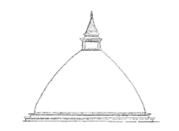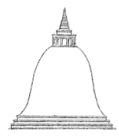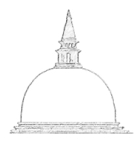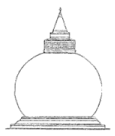Architecture of Sri Lanka
1/78
There's no tags or description
Looks like no tags are added yet.
Name | Mastery | Learn | Test | Matching | Spaced |
|---|
No study sessions yet.
79 Terms
Sinhala
Ancient name of Sri Lanka
Southern tip of India
Where Sri Lanka located?
Wet Areas
Clay for bricks, roof tiles and pottery is for dry areas?
Wet Areas
Stones (Granite, limestone, laterite and sandstone)
Wet Areas
Soft and hardwood timber, bamboo, grasses, for thatch and mats, and coconut trees
Dry Areas
Teak, satin, and other beautiful hardwoods
Cool and invigorating
What climate has central wet region
Heavy rainfall and high humidity
What kind of climate has low-lying hot wet zone in the south and southwest
Dry hot zone in the north and east
Early civilization vast irrigation tanks were built to conserve rain water
Low-lying hot wet zone in the south and southwest
Buildings were solid-walled with wide projecting eaves and verandahs and steep pitched roofs (rain and sun)
BUDDHISM
Known as Dharma-Dipa, the island of the Buddhist doctrine.
Mahinda Thera
Introduced by the missionary son of Ashoka, ____________________ in the reign of King Devanampiyatissa 3rd c. BC.
Sacred Bodhi Tree
Planted in Anuradhapura by Sanghamitta Thera (daughter) considered as one of the oldest trees in the world.
Sacred Bodhi Tree
Considered as one of the oldest trees in the world.
Sanghamitta Thera (daughter)
Who planted Sacred Bodhi Tree?
Adam’s Peak
Vertical and unmoving, established as the stable pivot around which the universe revolves — AXIS MUNDI
Axis Mundi
Vertical and unmoving, established as the stable pivot around which the universe revolves
Mountain
It is also the horizontal axis, grounding the gathered creative cosmic energy radiating it out in all direction
Adam’s Peak
Mountain is also the horizontal axis, grounding the gathered creative cosmic energy radiating it out in all directions.
Sree Padafoot (Sacred Foot Print)
Mark of Lord Shiva; for Buddhists, it is the foot print of Lord Buddha; Muslims and some Christians believe Adam first stepped down onto earth.
Sinhalese
Claim to be the earliest colonizers of Sri Lanka, first settling in the dry north-central regions as early as 500 BC
Anuradhapura, Polonnaruwa
Between the 3rd c BC. and 12th c AD. - developed a great civilization centered around the cities of ________________ and ____________________.
Hydraulic Engineering
Construction of water tanks (reservoirs) and irrigation canals.
Anuradhapura Period
First capital
Anuradhapura Period
One of the most progressive centers of political power and urban life in South Asia - popular as ritual and administrative center.
Sigiraya
Sinhalese King Kassapa I (6th c.) created a city in a rock hill, _____________.
Anuradhapura Period
Abandoned in 1017 AD.
Anuradhapura Period
Significant in Hindu legend as the fabled capital of the Asura King Ravana in the Ramayana
Polonnaruwa Period
Invaded and occupied by Cholan (South India).
Polonnaruwa Period
Capital city by King Vijayabahu I, who defeated the Chola invaders in 1070 AD to reunite the country.
Polonnaruwa Period
Also called as Jananathamangalam during the short Chola reign.
Polonnaruwa Period
is Anuradhapura Period called as Jananathamangalam?
Polonnaruwa Period
City was built by King Parakrama Bahu “The Great” (12th c.).
Polonnaruwa Period
Palaces, monasteries, temples, parks, lakes and irrigation works
Polonnaruwa Period
Series of impermanent settlements (13th -15th c.)
Kandyan Period
Divided into several kingdoms with its capital at Kandy.
British
Succeeded in annexing the Kandyan kingdom in 1815 until 1947 (Independence)-Colonial Georgian and Colonial Classic
Natural
Architectural Character
Rock Cut
Architectural Character
Based on Buddhist Principles
Architectural Character
Anuradhapura, Polonnaruwa
Relationship between building and landscape very important
Polonnaruwa
Expansion of temple to enshrine colossal Buddha statue
Polonnaruwa
Temples with interior corridors and processional areas
Kandyan
City placed on a hill
Anuradhapura
Brick work
White Plastered Walls
Polonnaruwa
Red Brick
Lime Plastered
Kandyan
Mostly Timber
Painted Walls
Dwarapalas
Door Keepers
Polonnaruwa
Windows with lacquered wood bars, carved timber doorways
Anuradhapura
Earliest remains are natural rock chambers built for hermits -with drip ledges to carry away rainwater; these later developed with walls to form enclosure (rock temples)
Rock Temples
Earliest remains are natural rock chambers built for hermits -with drip ledges to carry away rainwater; these later developed with walls to form enclosure.
Polonnaruwa
Development of a STUPA covered by a roof.
Kandyan
Roofs high pitched with wide eaves, slightly curved; finished with terra cotta tiles and eaves tiles with bas reliefs.
Kandyan
Is Polonnaruwa has a high pitched with wide eaves roof?
Anuradhapura
Square or Octagonal Sections
Anuradhapura
Capital is hexagon vase and abacus.
Polonnaruwa
Pillared Buildings
Polonnaruwa
Lotus Motifs
Kandyan
Timber columns
Polonnaruwa
4 entrances for a stupa at cardinal points
Polonnaruwa
Colossal Statues of the Buddha
Kandyan
Richly carved with traditional motifs: lions, lotus, geese, etc
Dagoba/Dagaba
Places to store ashes of monks who were cremated
Paddy-heap

Bell

Bubble

Pot

Sigiraya
Rising 200 m. from the plain Sigiraya - most remarkable of all of Sri Lanka’s former cities
Sigiraya
Palace was build surrounded by boulders and water gardens. A unique fortress with 1200 steps
Sigiraya
Series of paintings of beautiful women underneath the ruins of a magnificent palace on the top of an enormous rock.
Monastery Of Mahintale
Stands on a hill top 300 m.
Monastery Of Mahintale
Mahinda Thera, Emperor Asoka’s son preached to the court in 3rd c.
Monastery
Regarded as cradle of Sinhalese Buddhism
Monastery Of Mahintale
Large number of large steps were constructed to climb Mihintale. Stairway has 1840 steps made of granite, leading to the summit.
Courtyard
Which is not part of Buddhist Monastery
Temple
Dagoba – Focal point of the monastery
Bhodi-gara – shrine enclosing a sacred Bodhi Tree
Halls for ceremonies, meditation and preaching
Courtyard
Priory
Ponds and bathing places for drinking and ablution
Stupa
Is Dagoba/Dagaba called?
Tagong Temple
Which one is not of Temple in Sri Lanka
Lankatilleke Temple
Tagong Temple
Embekke Temple
Dalada Maligawa
Bodnath
Which one is not part of Dagoba/Dagaba?
Thuparama
Ruwanveliseya
Abhayagiri
Jetavanaram
Bodnath
Kiri Vihara
Watadage
Adam’s Peak
Religiously significant mountain.